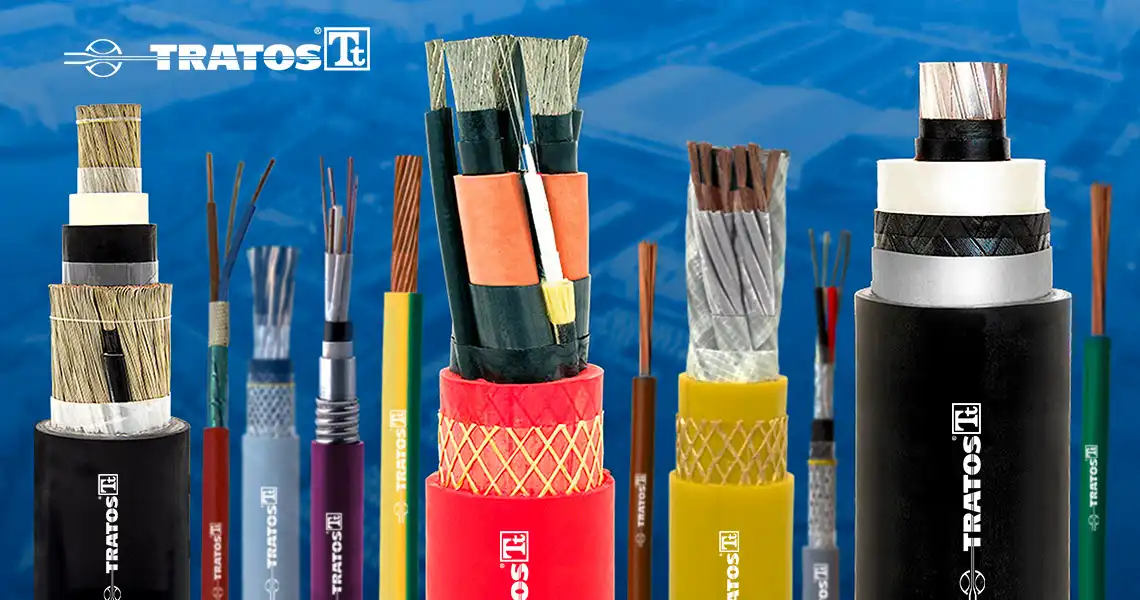TRATOS® PAS 5308 Part 1/Type 2 – Armoured Construction
Energy Cables / Low Voltage Cables - LV / LV Energy Cables BS

BS 5308 Part 1: Instrumentation Cables – Specification for Polyethylene Insulated Cables
BS 5308 Part 1 specifies the requirements and dimensions for polyethylene-insulated instrumentation cables. These cables are designed primarily for the petroleum industry and are used to connect electrical instrument circuits and provide communications. The cables include options for screens, single-wire armour, or lead sheath with single-wire armour for added protection. Although BS 5308 Part 1 was officially withdrawn in November 1986, Tratos can still manufacture cables to the designs previously included in the withdrawn standard upon request.
BS 5308 Part 1 cables are insulated with Polyethylene Type 03, suitable for operation at voltages up to 300 V r.m.s. core to earth and 500 V r.m.s. core to core, with a maximum operating temperature of 65°C. It is important to note that these cables are not intended for direct connection to low-impedance sources, such as public mains electricity supplies.
The conductors are made from plain annealed copper wire, ensuring excellent conductivity and durability. Two insulated conductors are twisted uniformly together to form a pair. For two-pair cables, if unscreened, the four cores are laid in quad formation around a central dummy. Pair identification for unscreened pairs is achieved through colour coding as specified in Annex A of BS 5308, while screened pairs are identified by either coloured insulation or a numbered polyester film.
Additional protection can be provided through the use of a single layer of galvanised steel wire armour or a lead sheath with single wire armour. The armoured versions (type 2 and 3) are suitable for underground installation, offering enhanced resilience in harsh environments. The outer sheath of the cables is made from durable PVC to ensure longevity and reliability.
These cables are primarily used in the petroleum industry and specified in BS 5308 Part 1. In contrast, BS 5308 Part 2 focuses on PVC-insulated cables, which are more commonly used in the chemical and petrochemical industries. While not suitable for coal mining applications (Group I), these cables may be appropriate for Group II intrinsically safe systems, subject to safety considerations outlined in the relevant warning notes.
Energy Cables / Low Voltage Cables - LV / LV Energy Cables BS
Energy Cables / Low Voltage Cables - LV / LV Energy Cables BS
Special Cables / Instrumentation Cables Special Cables / Oil & Gas Cables / Petrochemical Cables
Special Cables / Instrumentation Cables Special Cables / Oil & Gas Cables / Petrochemical Cables
Energy Cables / Low Voltage Cables - LV / LV Energy Cables IEC Special Cables / Oil & Gas Cables / Petrochemical Cables
Energy Cables / Low Voltage Cables - LV / LV Energy Cables IEC Special Cables / Oil & Gas Cables / Petrochemical Cables
Energy Cables / Low Voltage Cables - LV / LV Energy Cables IEC Special Cables / Oil & Gas Cables / Petrochemical Cables
Energy Cables / Low Voltage Cables - LV / LV Energy Cables IEC Special Cables / Oil & Gas Cables / Petrochemical Cables
Special Cables / Instrumentation Cables Special Cables / Oil & Gas Cables / Petrochemical Cables
Special Cables / Instrumentation Cables Special Cables / Oil & Gas Cables / Petrochemical Cables
Special Cables / Instrumentation Cables Special Cables / Oil & Gas Cables / Petrochemical Cables
Special Cables / Instrumentation Cables Special Cables / Oil & Gas Cables / Petrochemical Cables
Please, don’t hesitate to contact us for additional information on our company or our products.
Our website uses cookies and thereby collects information about your visit to improve our website (by analyzing), show you Social Media content and relevant advertisements. Please see our cookies page for further details or agree by clicking the 'Accept' button.
Below you can choose which kind of cookies you allow on this website. Click on the "Save cookie settings" button to apply your choice.

This content is blocked. Accept cookies within the '%CC%' category to view this content.